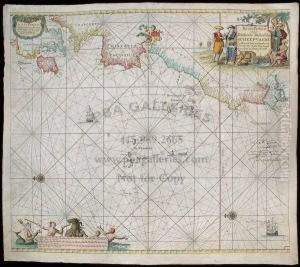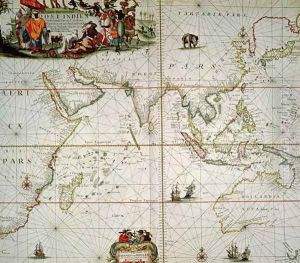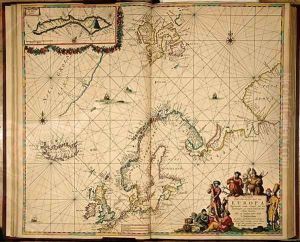Johannes van Keulen Paintings
Johannes van Keulen was a prominent Dutch cartographer, publisher, and bookseller known for his significant contributions to the field of maritime cartography and navigation during the Golden Age of Dutch mapmaking. Born in 1654 in Deventer, the Netherlands, van Keulen moved to Amsterdam, where he established his business in 1678. He quickly gained recognition and success in the competitive maritime market of Amsterdam, which at the time was a major hub for world trade and exploration.
In 1680, Johannes van Keulen acquired a privilege from the States General of the Netherlands, allowing him exclusive rights to print and publish maritime atlases and navigation manuals. This privilege enabled him to create works that were not only authoritative but also officially endorsed for use by sailors and navigators of the Dutch East India Company (VOC), a significant endorsement given the VOC's dominant role in global maritime trade.
Perhaps the most notable work produced by van Keulen was the 'Zee-Atlas' (Sea Atlas), first published in 1680, which was renowned for its comprehensive coverage of the world's oceans and coasts. This was followed by his seminal publication, the 'Zee-Fakkel' (Sea Torch), also known as the 'Pilot Guide' or 'Nieuwe Groote Lichtende Zee-Fakkel', a multi-volume nautical atlas that became the standard for sea charts in the 17th and 18th centuries. The 'Zee-Fakkel' contained detailed charts of all the major sailing routes of the time, and it was continually updated with new information as more of the world was explored.
Johannes van Keulen's business was a family affair, with his son, Gerard van Keulen, later taking over and continuing the production of high-quality nautical charts and expanding their scope. The firm, In de Gekroonde Lootsman (In the Crowned Pilot), flourished for many years and remained operational through several generations, contributing greatly to the legacy of Dutch maritime navigation.
Van Keulen's work was characterized by its accuracy, detail, and the artistic quality of its engravings. He engaged skilled cartographers and engravers, including the notable Claes Jansz Vooght, a mathematician and cartographer who worked closely with van Keulen on the 'Zee-Fakkel'. The charts often included elaborate decorative features such as cartouches, compass roses, and illustrations of ships, which were not only functional but also aesthetically pleasing.
Johannes van Keulen died in 1715 in Amsterdam. His legacy lived on through his descendants, who continued to publish under the family name well into the 19th century, cementing the van Keulen dynasty as one of the most important and enduring names in the history of nautical chart-making.


